7 Completely Insane Golden and Silver Age Superhero Origins
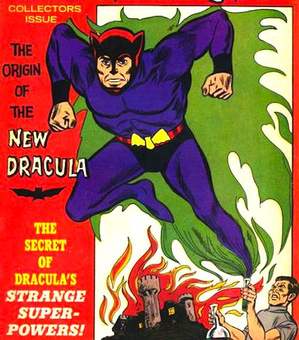 |
When you look at the most popular and enduring super heroes and heroines from comic books, you can’t help but take into consideration all the design and story elements that contribute to their pop culture celebrity. No matter how different they may be, nearly every great hero fundamentally boils down to that unique set of abilities, an iconic costume and their trademark insignia that sums up the entirety of the character within one universally recognized symbol. For all the good they do, however, these elements are meaningless if they’re missing an epic origin story that brings it all together with impact. But during the Golden and Silver Ages of Comic Books, a time when publishers were popping out of the woodwork literally overnight, a term like “epic” isn’t the best word to describe what they were putting out.
Due to the budding comic book industry’s unremitting demand for novel ideas while trying to keep pace with popular heroes like Batman, Superman and Captain America (with a lack of understanding of the medium thrown in), not every new super hero hoped to match the grandiose origin stories of those seen in the works of top-tier publishers. It was moments like these when creators were hard-pressed to deliver something fresh that they tended to think far outside standard convention and prove that maybe there is such a thing as being too original — or that there’s no shame in “borrowing” from other works granted you throw in a half-assed tweak or two. The end result? Origin stories that skate that fine line of being hilarious… and outright embarrassing. Read on for seven insane Golden and Silver Age hero origins!
7) Mr. Satan
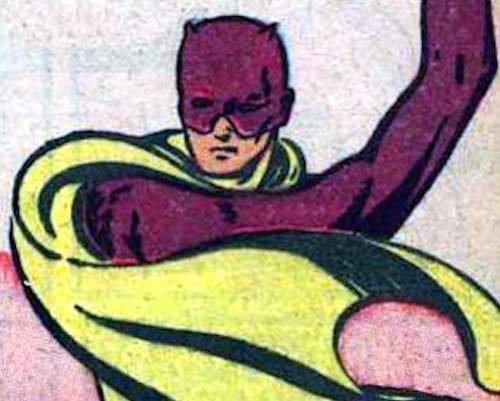 |
One of the many innumerable Batman rip-offs to surface during the Golden Age when blatant plagiarism was a widely accepted industry practice, the creators of Mr. Satan didn’t do much to hide the fact that their brainchild was an unabashed knockoff of DC’s resident dark knight. By day, Mr. Satan was, unbeknownst to the general public, cowardly millionaire playboy Dudley Bradshaw… like Batman (minus the cowardice). And by night he donned a grim costume to inspire terror in the hearts of the criminal element… like Batman.
This litany of uncanny similarities is endless, but, to the creators’ credit, they at least had the decency to save face by coming up with a truly unique origin story: none at all. Whether it was pure laziness or the fact Mr. Satan’s run within the pages of Zip Comics was — for self-evident reasons — short-lived, the character’s drive to combat criminals was never explained; it was chalked up to Mr. Satan fighting crime on the kind of whim people with way too much time and disposable income have. In addition to that, the guy bought his costume from a store without so much as worrying that the cashier would link Mr. Satan to that one customer who bought the purple devil outfit.
6) The Zebra
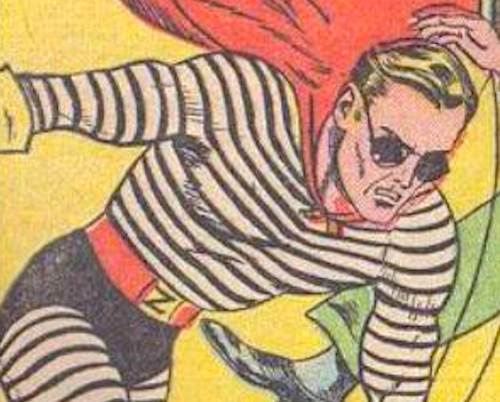 |
To quote the dubious words of superhero attorney Harvey Birdman, “A night in the pokey never killed anyone. It builds character.” While the validity of this statement is subject to debate among those that have committed a crime worthy of a prison sentence, a super hero such as the Zebra can vouch that truer words were never spoken. When lawyer John Doyle is falsely implicated in a crime as a means of revenge orchestrated by corrupt politicians and gangsters, he resolves to enact vengeance on those responsible for his imprisonment. But when you’re behind bars and that urge to become a masked vigilante is gnawing away, you have to make do with what you have when it comes down to fashioning a costume. In this case, striped prison duds.
Adding a red cape and yellow gloves and boots — gotta admit that they do compliment the black and white stripes — Doyle, now the Zebra, manages to escape his confinement and make good on his vengeful vow dressed like the Hamburglar. But you’d think that after apprehending his enemies and clearing his name he’d opt for a costume that doesn’t make him look like an escaped convict. Nah, the suit’s just so comfy you forget all about the associated stigma.
5) Press Guardian
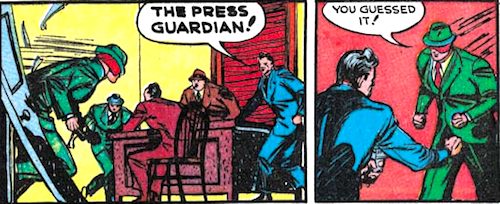 |
When nearly every known Golden Age comic book publisher was ripping off Superman in one outrageous form or another, publisher MLJ decided not to cave into peer pressure and instead steal and run with elements from perhaps the dullest part of any Superman comic book: Clark Kent’s droll exploits at the Daily Planet. In place of Clark we have soft news reporter Perry Chase — a man desperately vying for the approval of his rigid father, publisher at the Daily Express (name sound familiar?). But when Perry isn’t busy letting his father destroy every ounce of his self-esteem, he protects the innocent and the inalienable rights of the First Amendment as the Press Guardian!
By now you can no doubt see the underlying motive in Perry’s decision to become the Press Guardian: daddy issues. Why else would he be fighting crime dressed as a news reporter if not to prove he’s both a man’s man and ace journalist (both areas Perry’s father felt needed some work); Press Guardian is basically the physical embodiment of his father’s ideal. So are we looking at the saddest super hero with the most depressing origin story in the history of comic books? Quite possibly.
4) Red Rube
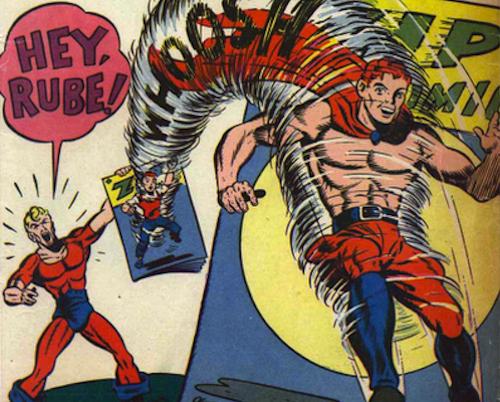 |
To rip off a popular comic book character without so much as hiding the fact is frowned upon. But to rip off a ripoff of a popular comic book character without so much as hiding the fact is proof that you’re an unrepentant dirtbag destined to rot in that special place in Hell reserved for greedy and unoriginal comic book creatives. To this day, comic book experts are still amazed that Captain Marvel, an early Superman knockoff, exceeded the popularity of its source material and continues to hold a special place in the hearts of many. But during the Golden Age, the idea thieves at MLJ were amazed that yet another potential cash-grab went unnoticed for so long (probably due to their being distracted by the staggering originality of Press Guardian).
Copying the origin story of Captain Marvel virtually verbatim, MLJ’s Red Rube was in actuality a boy named Rueben Rueben (?) that stumbled upon an old castle haunted by the ghosts of his relatives. Imbuing Rueben with their powers and extraordinary talents, he was able to transform into the kind-of-racial-slur-sounding hero Red Rube by shouting the pejorative statement “Hey Rube!” The difference between Captain Marvel and Red Rube is that — aside from the former’s publisher not experiencing a case of venomous bigotry — Cap M is given the powers and abilities of history’s greatest gods and heroes, not his own family! Think about it, what if Rueben’s legacy wasn’t so fantastic? What if, instead of super powers, he was given his family’s worst traits like morbid obesity, susceptibility to gallstones or IBS? Family’s great and all, but to hold a part of each of them within us is something we’d all pass on.
3) Scarlet Avenger
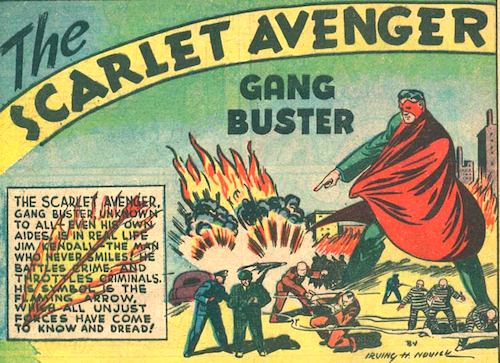 |
A word of advice: when you’re drafting the origin story for your hero, you have to know when you have that plausible explanation for the character’s heroic resolve and stop right there as soon as you do. Because if not, you’ll just end up with a hero like the Scarlet Avenger. During what was meant to be an uneventful flight aboard a plane carrying gold, scientist Jim Kendall and his family find themselves tangled in an attempted robbery that leaves the pilot dead and their plane plummeting towards the ground below. Walking away from the crash alive, Kendall is shocked to discover his wife and son have died and vows to avenge their deaths by striking back at the criminal element as the Scarlet Avenger.
Right there we have our motivation, but apparently the creatives behind Kendall’s story felt that this clearly wasn’t enough drive. In addition to losing his family, Kendall is also robbed of his ability to smile as a result of the crash. Our suspension of disbelief can only go so high, so to say that the immense physical trauma of the plane crash was localized entirely in his facial muscles is nothing short of insane and superfluous given that the death of his wife and son was motivation enough. If his being unable to smile was due solely to his tragic loss and anger towards criminals, now we have something, but for the Golden Age, that makes way too much sense — and the kids hate that!
2) Dell Comics’ Dracula
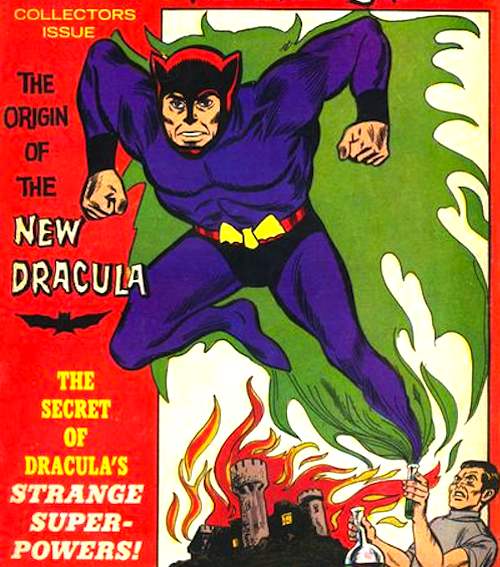 |
Like the angry pitchfork-and-torch-wielding villagers seen in those old Universal Monster movies, the Comics Code Authority — in league with the misinformed public — waged a fierce crusade against the depiction of vampires, werewolves, zombies, and other creatures of horror in comic books based entirely on unsubstantiated evidence (the best evidence of all) that such things incite juvenile delinquency. While some publishers, especially those specializing in the horror genre, reeled from this industry-wide ban, others were going to make use of their monstrous licenses one way or another. Enter Dell Comics and their Dracula series.
A far cry from the undead blood-drinker, Dell’s Dracula was actually a scientist and direct descendent of the original Count Dracula that gained vampire-like powers upon consuming, quite literally, bat juice when trying to create a serum that would remedy brain damage. How the creators were able to link brain damage to vampirism is anyone’s guess, but that’s about as epic as this story gets. Upon gaining the ability to turn into a bat, among other vampire powers, the doctor vows to become a hero not only to protect the innocent but to clear his family’s dark legacy… by donning a costume reminiscent of the same exact creature the world feared and despised in the first place. With an origin like that, is it any surprise Dracula only lasted three crappy issues?
1) Fighting American
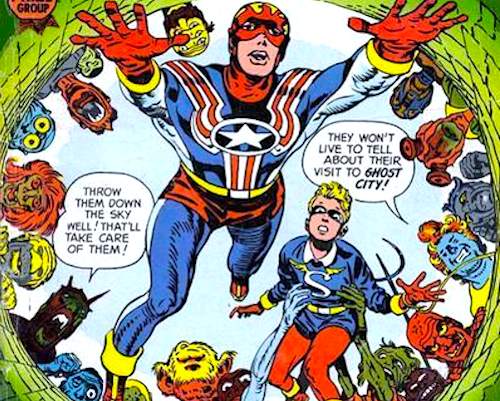 |
The funny thing about Fighting American is that he’d fall into obscurity with all the other star-spangled Captain America rip-offs if it were not for the fact that he was created by the same duo responsible for Cap: Joe Simon and Jack Kirby. Peeved that Atlas Comics (the predecessor to Marvel Comics) was launching a new Captain America series without their input, Joe and Jack gave their erstwhile employer the proverbial finger by publishing Fighting American — what they considered their way of demonstrating how Captain America should be handled… which they managed to blow upon the first issue with the character’s somewhat macabre and disgusting origin story.
Nelson Flagg’s brother and TV news commentator, Johnny, is killed by communists for his inflammatory opinions about the said group. Wishing to avenge his brother’s death, Nelson undergoes a ghoulish procedure that transfers his mind and soul into the lifeless corpse of his brother, awakening as Fighting American. Not dismissing the contributions of Joe and Jack by any means, you have to admit that these two could have come up with something other than a legally dead body springing back to life to kick communist ass so hard they turn capitalist. Then again, maybe the two did see how asinine their creation was when the series took a more comedic route after the very first issue. Beats having a crappy hero that’s supposed to be taken seriously.
